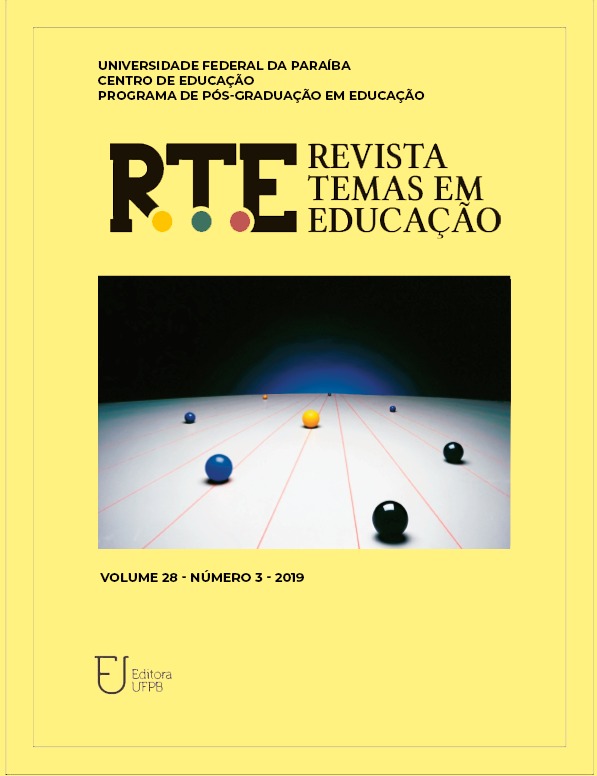ATTHE MOVIE PLOTS: BODY SENSIBILITIES AND DIGITAL TECHNOLOGIES IN THE TEACHING LEARNING RELATIONSHIP IN HISTORY
ATTHE MOVIE PLOTS: BODY SENSIBILITIES AND DIGITAL TECHNOLOGIES IN THE TEACHING LEARNING RELATIONSHIP IN HISTORY
DOI:
https://doi.org/10.22478/ufpb.2359-7003.2019v28n3.48543Keywords:
Body, Digital Technologies, Teaching-learningAbstract
Think the teaching-learning relationship in history is observe a universe of multiple possibilities. In this way, together the 9th grade of the elementary school at the Municipal School of Primary School Iran Coelho Dantas, located in Nova Palmeira -PB, the fan of possibilities was opened. Having as objective of thinking the body sensibilities and digital technologies in the teaching-learning relationship in History, starting on cinematic plots, this work out being sculpted. The research methodology consists of a qualitative exploratory-descriptive research. At first, in the screening of the movie “Guerra de Canudos”, followed by debate; After that, scenes from the movie were chosen to be reproduced by the students, which were divided into groups. After the construction / reproduction of the scenes, they were shown to the class and evaluated the work done, from debates and written production of questionnaires. The analytical procedures of the collected data were performed by thematic analysis. In the construction of the analysis of the material produced, we resorted to discussions about body, sensibilities, digital technologies, education, culture, history teaching, the relationship between cinema and history.In drawing and coloring this work, we observe that the thoughtful reflections are put in a way to inspire new teaching practices and promote teaching-learning relationships where the students put yourself as main characters, protagonists of their history in the ambit of school education.
Downloads
References
BOGDAN, Robert C.; BIKLEN, Sari Knopp. Investigação qualitativa em educação: uma introdução à teoria e aos métodos. Tradução de Maria João Alvarez, Sara Bahia dos Santos e Telmo Mourinho Baptista. Porto-Portugal: Porto, 2013 (Coleção Ciência da Educação).
CAMPELO, Cleide Riva. Cal(e)idoscorpos: Um estudo semiótico do corpo e seus códigos. São Paulo: ANNABLUME, 1996.
DIWAN, Pietra. Corpo. In: PINSY, Carla Bassanezi. Novos temas nas aulas de História. São Paulo: Contexto, 2010.
FANTIN, Mônica. Mídia-Educação e Cinema na Escola. In: Revista Teias. Rio de Janeiro, ano 8, nº 15-16, jan/dez 2007. p. 1-13.
FERRARI, Rodrigo Duarte. Ensinar-aprender cinema: através da percepção e cognição incorporadas. 2015. 202 f. Trabalho de conclusão de curso (Tese) – Programa de Pós-Graduação em Educação, Universidade Federal de Santa Catarina – UFSC, Florianópolis, SC, 2015.
FERRO, Marc. Cinema e História. 2.ed. São Paulo: Paz e Terra, 2010.
MARTÍN-BARBERO, Jesús. A comunicação na educação. São Paulo: Contexto, 2014.
MERLEAU-PONTY, Maurice. Fenomenologia da percepção. 2.ed. São Paulo: Martins Fontes, 1999.
NAPOLITANO, Marcos. Como usar o cinema na sala de aula. São Paulo: Contexto, 2015.
PALFREY, Jonh; GASSER, Urs. Nascidos na era digital: entendendo a primeira geração de nativos digitais. Porto Alegre: Grupo A, 2011.
PESAVENTO, Sandra Jatahy. Sensibilidades no tempo, tempo das sensibilidades. In: Nuevo Mundo Mundos Nuevos [En ligne], Colloques, mis en ligne le 04 février 2005, Consultado em 30 de julho de 2019. Disponível em http://journals.openedition.org/nuevomundo/229.
PRESNKY, Marc. Nativos digitais, imigrantes digitais. 2001. Consultado em 28 de agosto de 2019. Disponível em http://www.colegiongeracao.com.br/novageracao/2_intencoes/nativos.pdf
SILVA, Mozart Linhares da. A urgência do tempo: novas tecnologias e educação contemporânea. In: _____ (org.) Novas Tecnologias: educação e sociedade na era da informática. Belo horizonte: Autêntica, 2001.
WOODWARD, Kathryn. Identidade e diferença: uma introdução teórica e conceitual. In: SILVA, Tomaz Tadeu da (org.). Identidade e diferença: a perspectiva dos estudos culturais. 15. ed. Petrópolis, RJ: Vozes, 2014.
Downloads
Published
How to Cite
Issue
Section
License
Authors who publish in this journal agree to the following terms:
. Authors retain the copyright and grant the journal the right to first publication, with the work simultaneously licensed under the Licença Creative Commons Attribution that allows the sharing of the work with acknowledgment of authorship and initial publication in this magazine. . Authors are authorized to assume additional contracts separately, for non-exclusive distribution of the version of the work published in this journal (eg, publishing in institutional repository or as a book chapter), with acknowledgment of authorship and initial publication in this journal.
. Authors are permitted and encouraged to publish and distribute their work online (eg in institutional repositories or on their personal page) at any point before or during the editorial process, as this can generate productive changes, as well as increase impact and citation of the published work (See O Efeito do Acesso Livre).



















